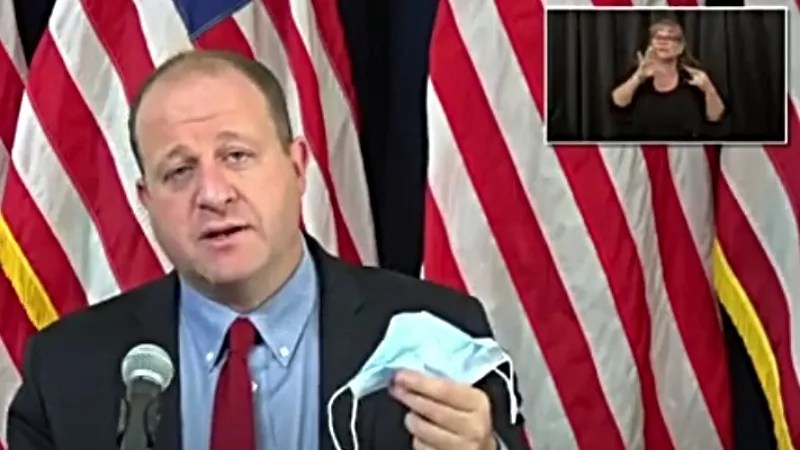
colorado.gov via YouTube

Audio By Carbonatix
Governor Jared Polis found himself in a tough spot during an October 20 press conference updating Coloradans about the spread of COVID-19. The latest data is as bad or worse than it was this past spring, when Polis imposed a statewide stay-at-home order – something he clearly doesn’t want to do again. So he’s trying a softer approach in tackling the current situation: a new publicity campaign intended to persuade residents engaging in unsafe behavior to start acting more responsibly in order to prevent the state’s hospital system from being overwhelmed.
“We cannot go on as we have been,” Polis stressed. “The status quo is not acceptable. We need to do a better job.”
After a brief introduction that included an update on the wildfires continuing to ravage significant sections of the state, Polis addressed what he described as “the concerning trend that we’re experiencing in many states in our country, including Colorado.” The latest daily count of 1,208 positive cases of the novel coronavirus here is a new record, and the positivity rate of 6.24 percent per 100,000 people is far above the 5 percent threshold set by the World Health Organization.
Moreover, Polis revealed that 417 people are currently hospitalized for COVID-19, occupying a little under one in four of the 1,800 or so medical-center beds statewide. That number seems to suggest that there’s plenty of wiggle room for more cases, but Polis argued otherwise. After all, those 1,800 beds need to be used for people with every type of condition: cancer, heart attack, stroke, brain trauma, injury from car accidents and more. As a result, the number of virus patients is already putting strains on capacity.
Will you step up to support Westword this year?
At Westword, we’re small and scrappy — and we make the most of every dollar from our supporters. Right now, we’re $20,000 away from reaching our December 31 goal of $50,000. If you’ve ever learned something new, stayed informed, or felt more connected because of Westword, now’s the time to give back.
Offering further perspective was Dr. Rachel Herlihy, the official state epidemiologist. She noted that various public-safety efforts, including mask-wearing, social distancing, frequent hand-washing, cutting down on personal interactions and avoiding large social gatherings translates to a decrease in virus transmission of around 66 percent. If the state doesn’t bump that number up to 75 to 80 percent in the next few weeks, Colorado’s current wave of infections could exceed the number of available hospital beds and the state’s intensive-care unit capability in late November or early December. If that happens, Colorado might be in the position of having to reopen alternative care sites that closed a few weeks ago.
Also troubling to Herlihy is the rise in the reproductive value of the virus in Colorado. Public-health pros have tried to keep the so-called “R-naught” below or no higher than one – the level at which an individual with the disease is passing it to only one other person. Right now, however, the R-naught is at 1.51, raising the specter of considerably greater spread.
According to Polis, these factors are particularly acute in several metro counties, including Denver, Arapahoe and Adams, with Mesa and Pueblo counties also seeing worrisome spikes. But rather than dealing with these scenarios through statewide measures, he promoted an individualized approach governed by the state’s COVID-19 dial framework. Colorado Department of Public Health and Environment Executive Director Jill Hunsaker Ryan explained that several of these areas have submitted plans to improve their statistics. In about ten days or so, the CDPHE will revisit the figures to see if progress has been made. If so, the counties will be allowed to remain at their current spot on the dial; if not, stricter measures will be imposed.
Following the main presentation and an announcement of $1 million in federal grants earmarked to help farmers, ranchers and members of the state’s agricultural community, Polis was asked whether he would impose new rules for the entire state if the numbers continue to deteriorate. Rather than address this directly, he focused on “Step Up Colorado,” a just-created series of public-service announcements that will begin rolling out on digital platforms immediately, with airings on radio and TV to follow. In the one screened today, a diverse cast of speakers could be seen talking about why they wear facial coverings and follow other public-health recommendations.
Here’s a “Step Up Colorado” post shared by Polis:
“Not everyone is watching me talk,” Polis acknowledged, “and most don’t watch these quality presentations. … We know we need to do a better job of reaching them and impacting their behavior.”
Polis undoubtedly realizes some people may doubt that a PR campaign will make much of a difference, since opinions about safety protocols are so entrenched. Furthermore, promoting masks didn’t measurably improve usage until after he issued an order that facial coverings had to be worn in stores and other indoor locations. “Policy works,” he conceded, “but it’s only about 20 percent of the equation. The other 80 percent is people’s endurance, caution, compliance and following science-based guidelines.”
In other words, Polis wants individuals to make a personal decision to don masks rather than mandate that they do so, and he prefers local public health agencies to address issues in their jurisdiction instead of waiting for him to take control. It’s an optimistic tack, and we should know soon whether it works – or if stronger measures must be taken.